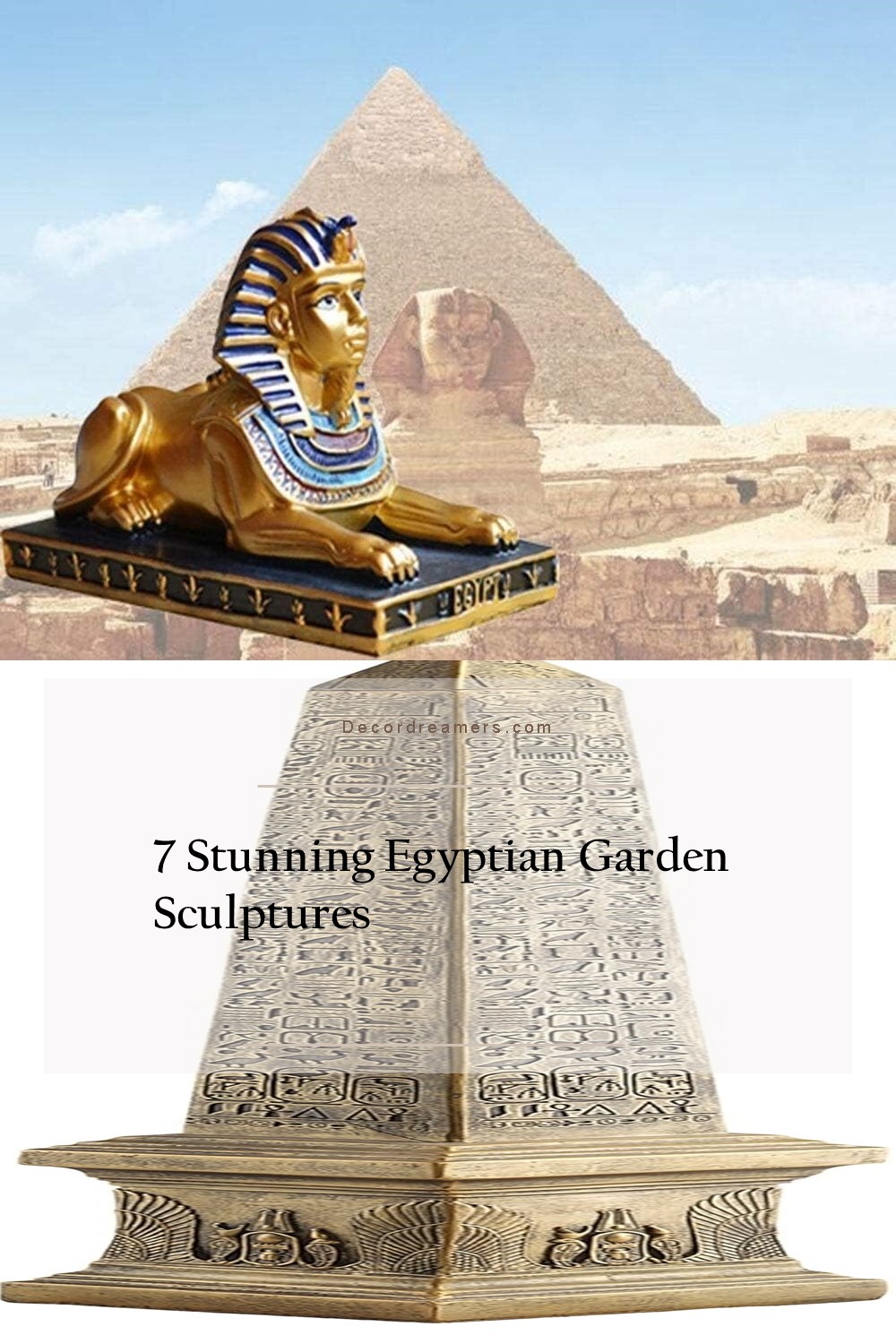Hey friends! Come on in, grab a cuppa, and let’s talk about something I’ve been absolutely *obsessed* with lately: transforming my outdoor space with the magic of Egyptian garden sculptures. I find there’s nothing quite like the feeling of creating a truly unique and personal oasis, but let’s be honest, decorating can sometimes feel a bit overwhelming! In my experience, finding the *right* pieces that speak to you and really elevate your space is key. That’s why I’m so excited to share my journey with you today – from the initial inspiration that sparked my love for these stunning pieces, to the simple yet effective ways I’ve incorporated them into my garden, creating a serene and captivating atmosphere. We’ll explore how to choose the perfect sculptures to complement your existing style, discover creative placement ideas that maximize their impact, and even touch on how lighting can really bring your Egyptian-inspired garden to life. So, whether you’re a seasoned gardener or just starting to explore outdoor decor, get ready to be inspired. Let’s dive in!
This post may contain affiliate links. If you make a purchase through these links, I may earn a small commission at no extra cost to you.

Adding Regal Charm to a Stark Patio Corner
Many patios suffer from an empty corner syndrome—a visually vacant space that feels unfinished. This set, with its antique bronze finish and regal posture, solves this perfectly. Position the centerpiece statue in your patio’s corner, creating a focal point. Flanking it with potted succulents in terracotta pots—their earthy tones complementing the bronze—will add a touch of organic softness. Consider adding a small, textured throw blanket in a deep teal or burnt orange draped casually over a nearby chair to echo the statue’s rich color and further ground the scene. This creates a layered, inviting corner that speaks of quiet sophistication.
The effect is transformative. This arrangement instantly elevates the patio’s aesthetic, creating a secluded, regal sanctuary where you can relax and unwind. The interplay of textures—the smooth bronze, the rough terracotta, and the soft blanket—adds visual interest and depth. Moreover, the adaptability of this decorative setup means you can easily swap out the plants seasonally to maintain a fresh, ever-evolving look, reflecting the changing moods of your outdoor space. It’s a small touch that makes a grand statement.

Transforming a Dull Balcony into a Sun-Kissed Oasis
Many balconies feel stark and uninviting, lacking a focal point that draws the eye. This set, with its golden finish and elegant obelisk form, is the perfect solution for adding a touch of regal charm to a small space. Place the obelisk slightly off-center on your balcony railing, letting it become a majestic centerpiece. Pair it with trailing ivy spilling over the edges of a simple, white planter box—the vibrant green will beautifully contrast against the gold. For added warmth, incorporate cushions in sunny yellow or soft terracotta tones. Arrange these on your balcony furniture for an inviting seating area. The verticality of the obelisk will draw the eye upward, creating a sense of spaciousness.
The result is a vibrant and welcoming outdoor sanctuary—a place where you can relax and enjoy the sun. The combination of the sun-kissed gold, lush greenery, and warm-toned textiles creates a feeling of serenity and joy. The compact setup ensures your space feels open and airy while providing a sophisticated focal point. And because the obelisk is a classic statement piece, this design works beautifully throughout the seasons, evolving with your changing preferences. It’s a small investment that delivers big on style and atmosphere.

Creating a Focal Point in a Bland Garden Bed
Many garden beds suffer from a lack of visual interest, appearing flat and uninspired. This elegant statue, with its rich bronze finish and regal pose, provides the perfect solution. Place it slightly off-center within your bed, allowing it to become a majestic focal point. To complement the bronze, plant low-growing, textural succulents or ornamental grasses around its base. The statue’s verticality will draw the eye upward, creating depth. Consider adding a small, rustic stone pathway or stepping stones leading up to the statue, creating a natural flow and adding to the overall visual richness. The warm tones of the bronze, the earthy greens of the plants, and the natural grey of the stones will work together beautifully.
The result is a garden bed that feels instantly more curated and captivating. The arrangement brings a sense of calm and sophistication, transforming a previously dull space into a small, private sanctuary. The interplay of textures and colors adds visual interest and draws the eye in a pleasing way. This design works particularly well in areas where you want to create a sense of stillness and quiet beauty, and the statue’s classic elegance will make it a treasured garden feature for years to come.

Infusing a Dull Patio with Ancient Majesty
Many patios feel incomplete, lacking a strong focal point to anchor the space. This elegant Anubis statue, with its rich bronze finish, effortlessly solves this. Position it slightly off-center against a wall or as a corner accent. The deep bronze pairs beautifully with warm terracotta pots filled with drought-tolerant succulents or lavender, echoing the statue’s earthy tones. A textured outdoor rug in a deep teal or rust color adds further visual grounding and warmth. Cluster the plants around the statue’s base, creating a layered display. The vertical lines of the statue add visual height, even in a small space.
The result is a patio transformed into a serene, sophisticated retreat. The combination of the weighty statue, the soft textures of plants and rug, and the carefully chosen colors instills a sense of calm and quiet strength. This design is adaptable; seasonal changes in plants and rug color allow for a fresh look throughout the year. It’s a thoughtful detail that elevates the overall ambiance, creating a space that feels both inviting and uniquely personal.

Enriching a Dull Garden Path with Ancient Majesty
Many garden paths lack a captivating focal point, leaving them feeling bland and unfinished. This unique Ancient Egyptian statue, with its rich bronze finish and regal presence, provides the perfect solution. Position it at a gentle curve or intersection along the path, allowing it to become a majestic centerpiece. Surround the base with low-growing, drought-tolerant plants like lavender or rosemary, their fragrant purple and green complementing the statue’s bronze tones. For added texture, incorporate natural stone stepping stones or gravel around the immediate area, drawing the eye towards the statue. This creates a layered, inviting scene, drawing the visitor deeper into the garden.
The result is a garden path transformed into a captivating journey. This arrangement infuses a sense of history and quiet grandeur, inviting a moment of contemplation at each pause. The interplay of textures—the smooth bronze, the soft foliage, and the rough stone—adds depth and visual interest. Moreover, this timeless piece works seamlessly with any seasonal changes to the surrounding plants, ensuring your garden’s story evolves along with nature’s beauty. It’s a small addition with a powerfully enriching effect.

Enlivening a Monochromatic Garden with Regal Bronze
Many gardens, while beautifully planted, can feel a bit flat visually, lacking a focal point of interest. This elegant Bastet statue, with its rich bronze finish and captivating pose, effortlessly injects personality and depth. Place it slightly off-center within a bed of low-growing succulents, the grey-green tones of which beautifully complement the bronze. Consider adding small, river stones around the base of the statue to ground it further and echo the natural textures of the surrounding environment. The statue’s verticality adds visual interest and draws the eye, preventing the garden bed from looking too uniform. Let the statue become a centerpiece, allowing the plants to create a soft, organic frame.
The result is a garden bed transformed from bland to breathtaking. The statue adds a touch of ancient majesty, creating a tranquil yet captivating corner. The combination of the bronze’s richness, the muted greens of the succulents, and the natural grey of the stones evokes a sense of calm sophistication. It’s a small addition that delivers a big impact, turning a previously ordinary space into a quietly stunning focal point within your garden. The piece’s classic style ensures it remains a treasured element for years to come, regardless of seasonal plant changes.

Conjuring Tranquility: A Serene Oasis in Your Garden
Many gardens feel incomplete, lacking a focal point to draw the eye and create a sense of calm. This thoughtfully designed sphinx, with its rich bronze finish, provides the perfect solution for infusing a sense of ancient majesty. Position it slightly off-center within a quieter section of your garden, perhaps near a water feature or a secluded seating area. Surround its base with low-growing, silvery-leaved plants like artemisia or dusty miller, echoing the bronze tones and creating a soft, textural contrast. Incorporate natural materials like river stones or gravel around the immediate area for a grounding effect. The sphinx’s horizontal lines create a sense of stability and serenity, drawing the eye and inviting quiet contemplation. Let it be a centerpiece to draw the visitor into the most peaceful part of the garden.
The result is a garden transformed into a serene sanctuary. The combination of the weighty statue, the carefully chosen plants, and the natural materials instills a sense of quiet strength and timeless beauty. The arrangement’s adaptability allows for seasonal variations in planting to keep the scene fresh and evolving. It’s a thoughtful detail that elevates the overall ambiance, creating a space that feels both inviting and uniquely personal—a place where you can truly relax and reconnect with nature’s tranquility.

Angelina leads the editorial desk at Live Green Gardens, blending practical plant care, hands-on product testing, and approachable outdoor styling. She focuses on step-by-step how-tos, buyer’s guides, and small-space makeovers that work in real life and real budgets. When she’s not comparing pruning shears or setting up a drip kit, you’ll find her creating cozy corners with planters, solar lights, and pollinator-friendly picks—always with clear pros/cons and safety notes so you can buy once and garden happy.

